| The MGA With An Attitude
MGA Twin Cam FRAME and BODY VARIATIONS - TC-201
One of the first changes to the MGA frame to accommodate the Twin Cam engine was to place the steering rack about an inch farther forward to clear the extended crankshaft pulley position.
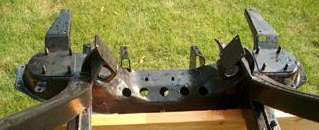 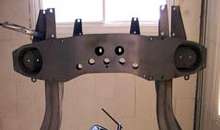
Very early in production five holes were added in the front cross member to allow easy access to the front bolts of the engine sump. If you have an early Twin Cam car which does not have these holes, you can add them as prescribed by the factory. From gathered statistics car no. 600 does not have the holes and 602 does, so it appears that the first 100 Twin Cam frames did not have them.
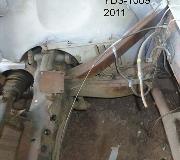
On the frame the right side engine mount is different, smaller and square rather than rectangular. This is to accommodate a lower position of the generator on the Twin Cam engine.
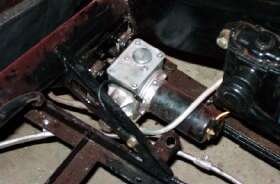
The frame bracket for mounting the fuel pump near the right size battery carrier is different to accommodate the higher output fuel pump used for the Twin Cam engine.
The starter switch bracket is different, partly welded, partly bolt-together, and includes mounting for the oil pressure gauge signal lines connector (pictures below).
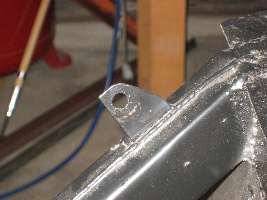
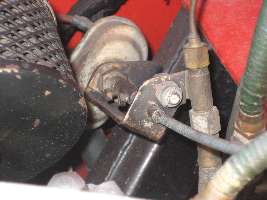
The MGA Twin Cam model has four wheel disc brakes with separate master cylinders for brakes and clutch. Thus the mounting bracket for the master cylinders is different (as well as the pedals). The bolt pattern in the frame is different to suit the master cylinder bracket, and spacing of other bolts along the top of the goalpost is also changed.
Use of the mirror image heater box for the Twin Cam car (to put the air intake hose on the left) required the rectangular aperture in the heater shelf to be moved to the right to retain centering of the overall housing of the box. Mounting bolt locations moved accordingly along with the aperture. This was a change to body metal only which did not affect the frame weldment. The heater blower then rotates in the opposite direction. The fuse box, flasher unit, and 1500 type turn signal relay are all relocated farther to the right on the bulkhead to clear the left side position of the heater blower motor.
Note that these body changes to accommodate the mirror image heater assembly are unique to the Twin Cam car, and are not found on the "Deluxe" model. This is to emphasize the fact that the "Deluxe" body is also unique in some respects, not like the Twin Cam or the standard body.
Another change was to add a bulge in the high right side of the gearbox tunnel at the front end to accommodate the higher starter position of the Twin Cam style gearbox. Nine months later the same change would be incorporated into the pushrod engine cars with introduction of the 15GD engine and gearbox with high starter position. Note that this change did not affect the frame weldment, but only the shape of the front tunnel section, the separate sheet metal bulkhead plate, and the plywood toe board.
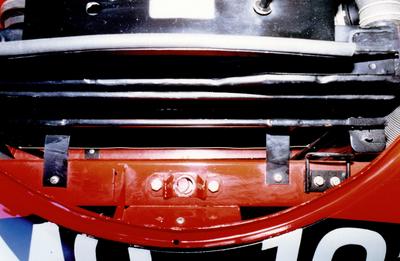
As the radiator is moved farther forward for the Twin Cam car, the radiator mounting diaphragm in the main body weldment is moved forward, and the horizontal air pan ahead of the radiator is shortened accordingly. This puts the radiator closer to the body brace which carries the bonnet latch mechanism. The picture above shows the optional radiator blind mounted in front of the Twin Cam radiator, with no space left for manual access to the area behind the grille.
To accommodate the forward height of the Twin Cam engine, the bonnet crown height was increased. The forward cross brace in the bonnet was also moved forward to clear the Twin Cam engine cam covers, and an attachment point for the prop rod was added on the opposite side (so the proprod would not foul on the carburetors). A small notch was also added in the right side front to back bonnet frame brace to clear the dashpot damper on the front carburetor. This taller crown bonnet was shortly thereafter incorporated into the 1500 pushrod car as a matter of production efficiency. After Twin Cam production ceased in May 1960 the taller bonnet was retained through end of MGA production.
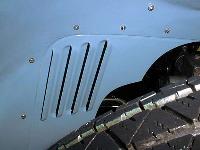
Five months into Twin Cam production (with slightly less than 100 cars produced) detachable panels were incorporated into the body front wheel arches for easier access to the engine components. Prior to this change some creative mechanics would add a slot in the right wheel arch for clearance for a long wrench for adjusting the dynamo and fan belt tension.
For the Twin Cam the inner fender has an additional indentation to clear the air filters. For those needing to replace this particular body part, it is possible to modify a standard body type inner fender to add this indentation. While it may be time consuming (and therefore relatively expensive) to do it right, there has been some discussion about not parting out an otherwise good Twin Cam body to get this part. The Twin Cam Coupe in particular is a very rare body type.
The 1600 body style was introduced in June 1959. Later in the same month chassis modifications were incorporated to accommodate installation of the front anti-roll bar. These changes were the same for the Twin Cam as for the 1600 pushrod engine cars, including indentation in the top of the front frame extension and modification of the spring pans and front wishbones.
|